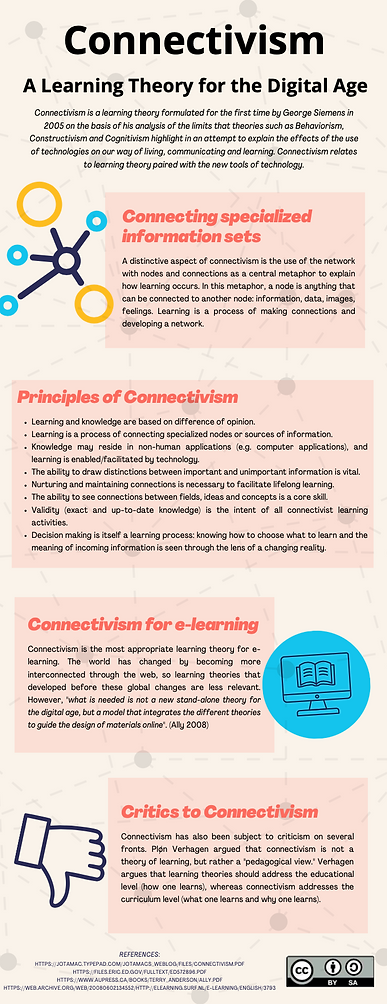Connectivism

A personal reflection on connectivism and Instructional Design
The changes brought by modern communication technologies (PCs, smartphones, internet…) are a total revolution in how we learn. Perhaps this revolution is comparable only to the invention of printing and the consequent unprecedented diffusion of information and knowledge in the following centuries (but in our case it is still too early to know the long-term consequences of this technological revolution).
For millennia knowledge was owned by a few, it was locked up in rooms with limited access and study materials were rare and difficult to obtain (and in most cases you could do nothing but trust what was written in the text). Today knowledge is widespread, we literally have it in our pockets, with our smartphone we can access all the knowledge in the world in a few moments, at any time and wherever we are. This opens up enormous potential, but also great risks. Selecting information, knowing how to choose sources, comparing our experiences with those of thousands of other people, but doing it critically are skills whose importance is often underestimated.
Critics to Connectivism by scholars such as Verhagen (compare with the infographic at the right side) have good points. However these critics may have value from an academic point of view, but from the point of view of an Instructional Designer they are of little importance. What actually matters for our needs is the impact that this vision of learning has in our profession, especially in relation to e-learning.
What is precious to us is the reflection on learning in the digital age. Fundamental in this sense are the principles that help the Instructional Designer to create online courses in which learning takes place in a way suited to the needs of the learner.
Proposing constant comparisons between peers, with the possibility of sharing one's personal experiences and reflections in a motivating and interactive way and showing where it is possible to find significant, correct and up-to-date information, among the numerous resources that the web makes available to us are points central to any modern teaching method.
Moreover is of strategic important to learn how to decrease to cognitive load that otherwise can became a barrier for effective learning. To be able to divide complex problems into smaller steps, with the right visual design principles and rhythm is essential for a deeper learning in a digital environment.
Beyond the controversy whether or not connectivism is a complete learning theory, what matters to us are therefore the thoughts and practical suggestions for creating effective e-learning courses. And this is a point of exceptional value.

References
-
Siemens, George. Jan, 2005. Connectivism: A Learning Theory for the Digital Age.
-
AlDadouh, A. A., Osório, A. J., & Portugal, S. C. (2015). Understanding knowledge network, learning and connectivism. International Journal of Instructional Technology and Distance Learning,12(10), 3-21. Retrieved November 11, 2018, from https://files.eric.ed.gov/fulltext/ED572896.pdf
-
Marc Clara, Elena Barbera. May 2013. Learning online: Massive open online courses (MOOCs), connectivism, and cultural psychology
Click on the icon to download the infographic in PDF.